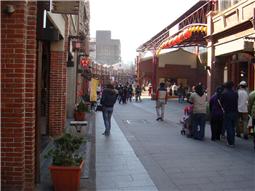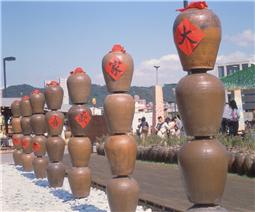City Tour

Sanxia is a traditional district located in northern Taiwan, easily accessible from Taipei. It has become known in recent years mainly because of its Qingshui Zushi (Divine Ancestor) Temple, which is unique among all the Chinese temples of the world for the painstaking and time-consuming dedication to classical temple arts that is manifested in its modern reconstruction work.
The town, originally named Sanjiaoyong after its location at the confluence of three rivers, was given its present name of Sanxia (Three Gorges, also the name of its main river) in 1920. Nestled where fertile plains meet mountain foothills, and blessed with convenient inland river transport, Sanxia offered excellent conditions for development in the early years of Taiwan's settlement by the Chinese. It quickly became an important goods distribution center and a base for the production of camphor, the growing of tea, and especially the dyeing of cloth. As transport shifted elsewhere and the use of river transportation declined, however, Sanxia gradually lost its importance as a commercial center.
Even as the town lost its economic importance, though, its cultural value remained undiminished, mainly because of Qingshui Zushi Temple. With its unparalleled combination of religion and art, this temple is the epitome of exquisite carving and complex structure as well as dynamic center of Chinese religious worship. These features have also made it a powerful attraction for tourists from all over Taiwan and the world.
Sanxia Old Street refers to the south section of Minquan Street in New Taipei City. Its length is about two hundred meters, and its architecture dates back to the early days when the Republic of China was newly established. Walking along Sanxia Old Street is like walking into a time tunnel; the arched red brick hallways, the traditional architecture, the beams, columns, ancient wooden plaques, the squat maidens walls and the figure carvings upon the buildings are all very unique. Walking along this ancient street brings a feeling of nostalgia for the good old days, and makes visitors want to linger. Sanxia Old Street is best preserved the along the Minquan Street, Heping Street, Ren’ai Street and Zhongshan Road. Minquan Street was the commercial center in the past, and the commercial stores and alleys that date back to the time of Japanese Occupation are still in good condition. Both the town and its street underwent modification during the Japanese Occupation; streets were expanded, rooftops, walkways, and drainage systems were also re-organized, and it was transformed into a stately, modernized street. During the time of Sanxia's heyday, the street was lined with shops that sold dyes, manufacturing materials, and tea, and western-style houses were also being built quickly. Nowadays, only the red brick buildings with arched hallways and Baroque styled architecture remain to tell of their past glory.
Yingge

Yingge is a pottery town, known as the "Jingde Township of Taiwan."The town has several hundred pottery plants, and equal numbers of pottery shops that sell their products. Jianshanpu Road is the origin of the local ceramics industry, and even today it has an old square coal-fired kiln chimney that serves as its landmark. Every October the town holds the Yingge Ceramics Festival; and, if you want to learn about the development of ceramics in Taiwan, the place to go is the Yingge Ceramics Museum.
Yingge was called Geshi in the past, because there was a bird-shaped stone near the town. After World War II, the government named this place. The so-called Ge Old Street is Jianshanpu Rd. After reconstruction, the old street has become a modern street, along which are pottery and porcelain shops. Though the old street no longer has its antique looks, some ancient buildings can still be found in Yingge Town. The new street is paved with beautiful rocks. Visitors can not only appreciate the pottery and porcelain works, but they can also enjoy the street performance and coffee on the street.
There are over 100 stores on the street. The products were pretty much the same in the past, but now the shops have their own workshops and artists. Each shop has its own characteristics and the pottery works are exquisite and refined. Some of the restaurants will give diners the cups or plates they use for free. Even the ice cream stand has lovely mugs and cups for customers to choose from. Besides purchasing the pottery and porcelain products, you can even learn how to make your own pottery works.
Information Provided by Tourism Bureau, Taiwan

